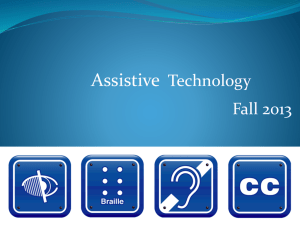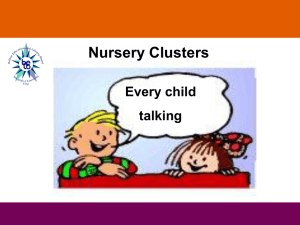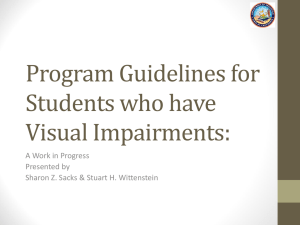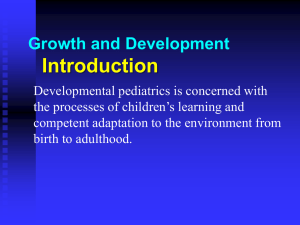The Role and Function of the Teacher of Students with Visual
advertisement
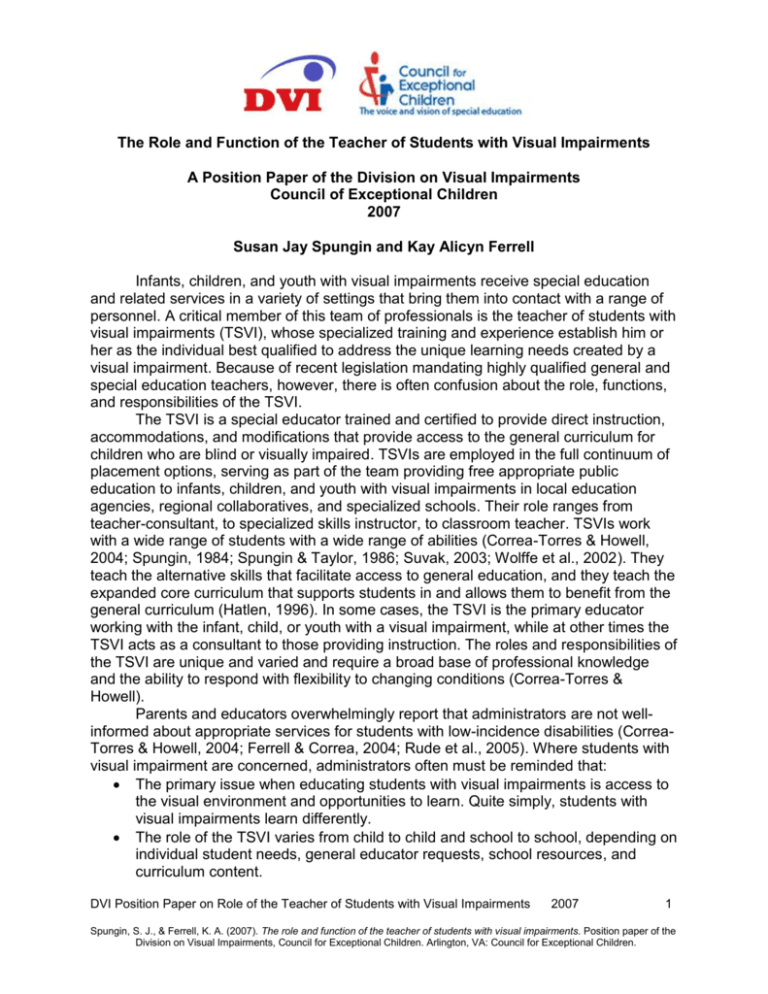
The Role and Function of the Teacher of Students with Visual Impairments A Position Paper of the Division on Visual Impairments Council of Exceptional Children 2007 Susan Jay Spungin and Kay Alicyn Ferrell Infants, children, and youth with visual impairments receive special education and related services in a variety of settings that bring them into contact with a range of personnel. A critical member of this team of professionals is the teacher of students with visual impairments (TSVI), whose specialized training and experience establish him or her as the individual best qualified to address the unique learning needs created by a visual impairment. Because of recent legislation mandating highly qualified general and special education teachers, however, there is often confusion about the role, functions, and responsibilities of the TSVI. The TSVI is a special educator trained and certified to provide direct instruction, accommodations, and modifications that provide access to the general curriculum for children who are blind or visually impaired. TSVIs are employed in the full continuum of placement options, serving as part of the team providing free appropriate public education to infants, children, and youth with visual impairments in local education agencies, regional collaboratives, and specialized schools. Their role ranges from teacher-consultant, to specialized skills instructor, to classroom teacher. TSVIs work with a wide range of students with a wide range of abilities (Correa-Torres & Howell, 2004; Spungin, 1984; Spungin & Taylor, 1986; Suvak, 2003; Wolffe et al., 2002). They teach the alternative skills that facilitate access to general education, and they teach the expanded core curriculum that supports students in and allows them to benefit from the general curriculum (Hatlen, 1996). In some cases, the TSVI is the primary educator working with the infant, child, or youth with a visual impairment, while at other times the TSVI acts as a consultant to those providing instruction. The roles and responsibilities of the TSVI are unique and varied and require a broad base of professional knowledge and the ability to respond with flexibility to changing conditions (Correa-Torres & Howell). Parents and educators overwhelmingly report that administrators are not wellinformed about appropriate services for students with low-incidence disabilities (CorreaTorres & Howell, 2004; Ferrell & Correa, 2004; Rude et al., 2005). Where students with visual impairment are concerned, administrators often must be reminded that: The primary issue when educating students with visual impairments is access to the visual environment and opportunities to learn. Quite simply, students with visual impairments learn differently. The role of the TSVI varies from child to child and school to school, depending on individual student needs, general educator requests, school resources, and curriculum content. DVI Position Paper on Role of the Teacher of Students with Visual Impairments 2007 1 Spungin, S. J., & Ferrell, K. A. (2007). The role and function of the teacher of students with visual impairments. Position paper of the Division on Visual Impairments, Council for Exceptional Children. Arlington, VA: Council for Exceptional Children. Responsibilities and time commitments are variable and sometimes unpredictable, because they are adjusted according to student and team needs at any given point in time. Each addition to the caseload increases time commitments exponentially. Paraprofessionals are helpful additions to the educational team, but they do not supplant TSVIs. Education is more than academic skill – it is a whole range of behaviors that prepare students for life after school. What typical students learn incidentally cannot be assumed to occur for students with visual impairments unless deliberately taught. (Ferrell, 2004) Recommendations Assessment and Evaluation Visual impairment occurs so infrequently in the school-age population (Adams, Hendershot, & Marano, 1999; Jones & Collins, 1966; Wenger, Kaye, & LaPlante, 1996) that few school psychologists are able to obtain adequate experience evaluating students with this disability. TSVIs are trained not only to conduct formal and informal assessments, but to assist other educational professionals in understanding and interpreting testing results. TSVIs therefore: 1. Participate in the multidisciplinary assessment of infants, children, and youth with visual impairments and assume the primary responsibility to: a. Conduct and interpret functional vision assessments. b. Obtain and interpret all ophthalmological, optometric, and functional vision reports and explain the implications of these reports for both distance and near vision in educational and home environments, to families, classroom teachers, and other team members. c. Modify existing assessment measures and procedures and develop new informal instruments as needed to assess and evaluate disability-specific skills (National Board of Professional Teaching Standards, NBPTS, 2001). d. Conduct and interpret communication skills and learning media assessments in reading, writing, and listening, as well as assessments that identify the most appropriate technology configurations for individual students. e. Recommend and collaborate in appropriate specialized evaluations as needed, including clinical low vision, orientation and mobility, physical therapy, occupational therapy, behavioral, physical education, speech and language, augmentative communication, aptitude, and vocational skills assessments. f. Identify and assist in making individualized accommodations for state- and district-wide performance assessments; g. Assist families to assess their own strengths and needs regarding their children’s visual, academic, functional, and social-emotional development. 2. Participate in multidisciplinary and transdisciplinary teams that develop Individualized Family Service Plans (IFSPs), Individualized Education Programs DVI Position Paper on Role of the Teacher of Students with Visual Impairments 2007 2 Spungin, S. J., & Ferrell, K. A. (2007). The role and function of the teacher of students with visual impairments. Position paper of the Division on Visual Impairments, Council for Exceptional Children. Arlington, VA: Council for Exceptional Children. (IEPs), Individual Transition Plans (ITPs), and other planning documents, for infants, children, and youth with visual impairments, and assume the primary responsibility to: a. Interpret instructional implications of evaluation results (Riley, 2000). b. Contribute to statements of present levels of performance by discussing how performance is affected by the visual impairment (IDEA, 2004, § 614(d)(1)(A)(i)(I)(aa)) and by providing information on students’ learning styles, utilization of visual information, tactual abilities, and other strengths unique to infants, children, and youth with visual impairments. c. Inform other members of the educational team about how prescribed medications may impact visual performance (Council for Exceptional Children, CEC, 2003). d. Identify goals and objectives in academic areas that require alternative approaches because of the student’s visual impairment. e. Identify goals and objectives in areas of the expanded core curriculum. f. Identify instructional methods and materials for meeting goals and objectives. g. Recommend appropriate service delivery options, including placement, physical education and related services, specialized equipment, modifications to testing procedures, and time frames for implementation. 3. Recommend as early as possible appropriate reading and writing media for the child with visual impairments. TSVIs base such recommendations on the specific needs of individual students, as demonstrated by a thorough communication skills and/or learning media assessment that considers such factors as reading distance, reading rates and accuracy, portability of reading skills, visual fatigue, and tactual sensitivity (Spungin, 1996). IDEA (2004) requires the IEP team to specifically consider braille instruction for each student (§ 614(d)(3)(B)(iii)). Educational and Instructional Strategies: Learning Environment While the No Child Left Behind Act of 2001 mandates that regular education teachers provide instruction to all students (§ 662(a)(4)), including those with special learning needs, the TSVI acts as the primary mediator of the learning environment for children with visual impairments (Davidson & Simmons, 1984; Simmons & Davidson, 1984). The TSVI implements various strategies to facilitate students’ assimilation into the classroom, school, community and work environment (NBPTS, 2001). In order to accomplish this, the TSVI takes steps to: 1. Assure that the student has all educational materials in the appropriate format, including textbooks, workbooks, handouts, periodicals, multimedia materials, and teacher-prepared supplements. 2. Assure that the student is trained in the use of, and has available, all optical, nonoptical, and electronic technology devices necessary for learning. 3. Instruct the student in developmental skills, academic strategies, and other activities that require modification, adaptation, or reinforcement as a direct result of the visual impairment. DVI Position Paper on Role of the Teacher of Students with Visual Impairments 2007 3 Spungin, S. J., & Ferrell, K. A. (2007). The role and function of the teacher of students with visual impairments. Position paper of the Division on Visual Impairments, Council for Exceptional Children. Arlington, VA: Council for Exceptional Children. 4. Recommend seating and other environmental modifications that maximize students’ utilization of visual information and facilitate movement of the student with visual impairments within the class. 5. Assure that the educator providing direct instruction fully understands the unique learning needs of infants, children, and youth with visual impairments. 6. Suggest accommodations needed for assignments or testing procedures. 7. Collaborate with teachers and other professionals regarding methods for including students with visual impairments in classroom activities, by promoting, modeling, and demonstrating the use of concrete, active, and structured learning experiences (NBPTS, 2001) that do not leave learning to chance. 8. Act as a catalyst to develop an understanding of visual impairment by classmates and peers without disabilities. 9. Assist family members to understand the impact of visual impairment on family systems and the possible effects on children’s self esteem (CEC, 2003). Educational and Instructional Strategies: Accessing the General Curriculum Students with visual impairments have the same curriculum needs as all children, but their visual impairment itself often imposes restrictions on their ability to access curriculum when presented in the typical method of learning and teaching by the classroom teacher. Students with visual impairments must be taught the necessary skills to obtain access to information (Riley, 2000), particularly in the high-stakes environment of a standards-based curriculum. The TSVI is responsible for providing direct or collaborative instruction in the following areas that are directly related to classroom instruction and to students’ access to the curriculum: Literacy (braille, print, aural, electronic). Literacy includes alphabetics, fluency, comprehension, computer technology, and writing skills, in either braille or print, according to the student’s needs and as specified in the IEP. For the braille student, these skills usually require introduction to the mechanical aspects of reading and writing, including spatial orientation to the page and use of the braillewriter, slate and stylus, and electronic devices, and include application and reinforcement of decoding, comprehension, encoding, writing, and composition strategies taught by the classroom teacher. “For a child to be proficient in braille, systematic and regular instruction is essential” (Riley, 2000, p. 36589). Computer technology is one of the five components of reading identified by the National Reading Panel (2000). The TSVI is responsible for collaborating with the teacher of computer technology and the classroom teacher to assist the student with visual impairments to use computers. The TSVI must remain current with the variety and range of adaptive technology available (such as hardware and software applications that provide screen access through speech or magnification; refreshable braille displays, PDAs, embossers, scanners, printers, braille translation software, etc.), in order to match technology to individual student characteristics. When print is the medium indicated for a particular student, the TSVI teaches the utilization of print adaptations (e.g., font size, acetate sheets, print color, background color, contrast, reading stands, magnifiers, and telescopes) and learning devices (e.g., DVI Position Paper on Role of the Teacher of Students with Visual Impairments 2007 4 Spungin, S. J., & Ferrell, K. A. (2007). The role and function of the teacher of students with visual impairments. Position paper of the Division on Visual Impairments, Council for Exceptional Children. Arlington, VA: Council for Exceptional Children. tape recorders, signature guides) that allow students to participate independently in regular classroom activities. Instruction to develop listening skills is important to students with visual impairments as a foundation for aural learning and reading, as well as for mobility clues, social conversation, and interpretation of a variety of auditory signals received from the environment. Listening becomes particularly important in the secondary grades, when reading assignments increase dramatically in length. TSVIs are familiar with a variety of devices that can convert text to speech and that allow students to control the speed of recorded and electronic speech. Listening skills are sequentially and deliberately expanded during the school years by TSVI instruction. For most students with visual impairments, keyboarding may be the major means of written communication between the child and his or her peers, family members, and teachers. Touch-typing and keyboarding skills are carefully and thoroughly taught by the TSVI as soon as the student has sufficient fine motor skills. For students with low vision, certain aspects of both manuscript and cursive handwriting (e.g., size, configuration, place-keeping, proofreading, reading aloud) are the responsibility of the TSVI. The TSVI teaches signature writing and additional handwriting skills that may be needed by students who are blind. TSVIs also perform a variety of tasks that facilitate students’ integration into classroom routines by transcribing, proofreading, and interlining brailled assignments to facilitate review by classroom teachers, as well as producing brailled materials for students to use in classroom activities (CEC, 2003). The TSVI also provides instruction in other expressions of literacy, such as braille music, computer braille, and foreign language braille codes. Mathematics. Mathematics skills emerge as a visual skill and develop into advanced graphical and spatial relationships. Children with visual impairments thus need specific instruction, including the abacus, talking calculator, concrete materials, and tactile graphics, to understand and reproduce these relationships in a non-visual format. Tactual Skills and Tactile Graphics. The development of tactual skills is not confined to the reading of braille. The TSVI provides instruction in tactual skills in a variety of environments and functional applications, assisting children with visual impairments from infancy to use their fingers and hands in order to explore, identify, discriminate, and appreciate all tangible materials in the environment. TSVIs are skilled in describing photographs and drawings to convey meaning and in creating tactile representations of graphical images, including maps, to assure access to the same information available to classmates (NBPTS, 2001). Organization and Study Skills. Skimming braille or print materials, outlining in braille or large print, searching for significant information in recorded materials, and other note taking, report-writing, and reference methods are fundamental study skills which require instruction by the TSVI because of the unfamiliarity of the media to most classroom teachers. Second Language Learners. TSVIs also support the instruction of children with visual impairments who are learning a second language (Milian & Pearson, 2005; NBPTS, 2001). Depending on the approach to bilingual instruction, this support includes at least preparation of materials in both English braille and in the student’s native DVI Position Paper on Role of the Teacher of Students with Visual Impairments 2007 5 Spungin, S. J., & Ferrell, K. A. (2007). The role and function of the teacher of students with visual impairments. Position paper of the Division on Visual Impairments, Council for Exceptional Children. Arlington, VA: Council for Exceptional Children. language. The second language learner has the same educational needs as all children with visual impairments, and the TSVI contributes to the educational team in much the same way. Educational and Instructional Strategies: Teaching the Expanded Core Curriculum The TSVI is also responsible for a number of areas that support student access to the general curriculum. Often referred to as the expanded core curriculum (Hatlen, 1996), these strategies facilitate students’ participation in a variety of educational activities by developing skills acquired incidentally by children without visual impairments. Social Interaction Skills. Reduced vision often interferes with human interaction. Not only is the amount of shared experience reduced, but the inability to use facial expressions and other forms of non verbal communication to both receive and convey information can lead to misperceptions and misunderstandings. Some research indicates that children with visual impairments have difficulties initiating interactions with peers and spend much of the school day in silence (Erwin, 1991). The TSVI creates opportunities for children with visual impairments to interact with others and instructs students in appropriate behaviors and conversations (Sacks, Lueck, Corn, & Erin, 2005). Orientation and Mobility. Most of the orientation and mobility needs of students with visual impairments are the responsibility of the certified orientation and mobility specialist (COMS). The responsibilities of and the relationship between the TSVI and COMS can differ according to student age, so responsibilities are collaboratively defined through the IEP. For example, the TSVI may assume responsibility for assuring that students develop in sensory motor, gross, and fine motor domains, while the orientation and mobility specialist assumes responsibility for instruction in environmental orientation and travel within the community. Children with visual impairments often must be taught to explore and move around in space and to be aware of the environment around them. They must learn to use tactual, auditory, and olfactory cues to identify their position in space and the relative position of other persons and objects around them. When working collaboratively, TSVIs can reinforce pre-cane, travel, and orientation skills introduced and monitored by the COMS (Wolffe et al., 2002). In some cases, the TSVI is dually certified both as a teacher and an orientation and mobility specialist. Communication Development. Infants, children, and youth with visual impairments may experience difficulties in language acquisition and application. TSVIs are knowledgeable about the ways in which a visual impairment can affect receptive and expressive communication and employ specific strategies to encourage use of functional, reality-based language. In addition, TSVIs collaborate with other team members to instruct students with multiple disabilities in the use of manual communication, communication boards, and other augmentative communication techniques. Visual impairments impose restrictions on the use of these procedures, and the TSVI helps to devise alternative methods to make them accessible to infants, children, and youth with visual impairments. DVI Position Paper on Role of the Teacher of Students with Visual Impairments 2007 6 Spungin, S. J., & Ferrell, K. A. (2007). The role and function of the teacher of students with visual impairments. Position paper of the Division on Visual Impairments, Council for Exceptional Children. Arlington, VA: Council for Exceptional Children. Motor Development. The TSVI is knowledgeable about areas of motor development for infants, children, and youth with visual impairments that may be affected by visual impairment (for example, body image, body in space concepts, visual motor coordination, abnormal reflex patterns, locomotion, balance, rotation, weight transfer, gait, and posture). The TSVI works collaboratively with early interventionists, physical education teachers, COMS, and occupational or physical therapists to develop and enhance motor skills in infants, children, and youth with visual impairments. Concept Development. The TSVI shares with other professionals the responsibility for the development of basic concepts, which are often at risk without vision to mediate and integrate other sensory information. Future learning is dependent upon the student’s thorough understanding of basic spatial, environmental, social, and mathematical concepts, which lead to categorization, symbolization, and higher level thinking skills. The TSVI, in collaboration with the COMS, introduces these concepts systematically and sequentially within the context of other instruction. Vision Utilization. For the student with low vision, the utilization of visual information contributes to achievement in every skill area: academic, psychomotor, self-help, vocational, motor, and social skills. The TSVI provides “regular and intensive intervention” (Riley, 2000, p. 36589) to assist children with visual impairments to use and interpret visual information under a variety of conditions. Activities of Daily Living. Thorough knowledge of the activities and techniques of daily living and personal management skills is needed to create independence so that students with visual impairments may integrate more easily into culture and society. TSVIs share responsibility with family members and other professionals for instruction in such areas as personal hygiene, eating habits, manners, dressing, grooming, verbal and nonverbal communications, and developing a positive self image. Physical Education and Sports. TSVIs assist physical education teachers in integrating the child with visual impairments into the regular physical education curriculum by suggesting strategies for participation in team and individual sports. Visual impairments often unnecessarily restrict movement and may result in poor physical fitness (Oh, Ozturk, & Kozub, 2004), unless systematic efforts are made to include children with visual impairments in physical education and recreational activities (Tutt & Brasher, 2006). Children with visual impairments who are included in regular physical education classes are more likely to participate in organized sports activities as adults (Rizzo et al., 2003). Human Sexuality. TSVIs, parents and others share the responsibility for gradual, sequential instruction in human sexuality for students with visual impairments. Because these programs assume that much information has previously been attained visually, the student with visual impairments may need a specific hands-on curriculum taught by appropriate, well-prepared professionals. Career Education. Career education curricula that are developed for children without visual impairments may need supplementary explanation and instruction from a TSVI. This instruction may include field trips into the community to explore work opportunities and job requirements, interviews with adults with visual impairments about their various occupations, and assessment of individual abilities. While career education is often neglected (see Wolffe et al., 2002), it is one area that directly relates to the future employability of individuals with visual impairment. DVI Position Paper on Role of the Teacher of Students with Visual Impairments 2007 7 Spungin, S. J., & Ferrell, K. A. (2007). The role and function of the teacher of students with visual impairments. Position paper of the Division on Visual Impairments, Council for Exceptional Children. Arlington, VA: Council for Exceptional Children. Vocational Counseling and Training. Vocational counseling and transition to vocational opportunities are integral parts of programs designed for students with visual impairments. The TSVI, in conjunction with the vocational counselor or teacher, involves students with visual impairments and their parents in this counseling process. The TSVI assists in the assessment of vocational strengths and weaknesses and facilitates students’ participation in work-study, vocational training, and other appropriate experiences. Leisure and Recreation. The TSVI, parents, and community agencies share a responsibility to expose the student to, and provide learning opportunities in, a wide variety of leisure time activities that have carry-over value to adult life. Transition. The TSVI assists in the smooth transition of infants, children, and youth with visual impairments and their parents from one placement to another, by working with other team members, including parents, to identify appropriate options, preparing new teachers to accept students with visual impairments, and providing ongoing consultation. Such services regularly occur at the transition from early intervention to preschool programs, from preschool to school-age programs, from elementary to secondary programs, and from secondary to post-secondary and adult services, but may also be necessary when a major change in placement occurs (e.g., from regular class to special class, or from residential school to regular class placement), or even in the regular grade level progression within the same educational facility. Fine Arts. Music, visual arts, performing arts, and dance are common childhood experiences that help to unite members of society through an appreciation of nature, spirituality, and aesthetics. Children with visual impairments are sometimes directed towards music to express their creativity and are often assumed to be unable to participate in other art forms. TSVIs can assist fine arts teachers to include students with visual impairments in class activities by adapting procedures and modifying materials. TSVIs encourage students with visual impairments to express themselves through art, music, and/or dance and help students explore various media, use other senses for expression, and provide braille music when appropriate (NBPTS, 2001). Reasoning. The ability to reason, especially in the abstract, may require specific instruction from the TSVI. Students may need assistance in the development of thinking, decision-making, and problem solving skills, and in learning to live with occasional frustration and failure. Guidance and Counseling TSVIs provide guidance and counseling to infants, children, and youth with visual impairments and their families to: 1. Interpret implications of visual impairment for overall development. 2. Facilitate understanding of society’s attitudes concerning visual impairment and assist students and families in formulating their responses to misconceptions, lowered expectations, and prejudice. 3. Explore similarities and differences in relation to all children. 4. Develop social awareness of self, others, and the community at large. DVI Position Paper on Role of the Teacher of Students with Visual Impairments 2007 8 Spungin, S. J., & Ferrell, K. A. (2007). The role and function of the teacher of students with visual impairments. Position paper of the Division on Visual Impairments, Council for Exceptional Children. Arlington, VA: Council for Exceptional Children. 5. Encourage social interactions with peer groups and adult role models (CEC, 2003). 6. Identify functional, academic, and vocational potential. 7. Encourage home involvement in program objectives. 8. Promote independence and self-advocacy skills in infants, children, and youth. 9. Develop positive evaluations of self worth by providing opportunities to both achieve and fail (Chang & Schaller, 2002). 10. Plan for adult life by exploring options for college, technical or trade school, job coaching programs, industrial enclaves, and other post-secondary placements, as well as identifying independent living arrangements in the community. 11. Identify other sources for additional guidance and counseling services. Administration and Supervision The TSVI, depending on the model(s) of service being utilized (specialized school, special class, resource room, itinerant, or teacher consultant) has a variety of administrative roles. In a large program, this may include supervision of other TSVIs, in addition to working with directors of special education, principals, regular classroom teachers, and other educational and related services personnel. Some of the most common activities in this area may include: 1. Communication with Administrators. TSVIs keep administrators informed concerning: a. Student information (e.g., visual status, grade level, educational needs). b. Program goals and activities. c. Program evaluation. d. Screening and referral procedures. e. Relationships between the program for students with visual impairments and regular and special education programs and support services. f. Funding requirements for consultation, instruction, salaries, travel time, travel expenses, instructional materials, technology, preparation time, conferences, and benefits. g. In-service needs for TSVIs, as well as for other regular and special education personnel. h. Staff scheduling requirements, including adequate time for planning, preparation, report writing, travel, direct instruction, team meetings, and staff conferences, as well as the need for flexibility in assignments and instruction that may occur outside the school day and building. i. Physical facilities, including design and selection of classroom environments and office space, as well as adequate storage space for instructional materials and equipment. j. Student scheduling, including preparation of a master schedule to be given to the supervisor and principal(s) of the building(s) in which students are served. k. Equipment needs, particularly in the area of technology, but also including materials and learning devices. DVI Position Paper on Role of the Teacher of Students with Visual Impairments 2007 9 Spungin, S. J., & Ferrell, K. A. (2007). The role and function of the teacher of students with visual impairments. Position paper of the Division on Visual Impairments, Council for Exceptional Children. Arlington, VA: Council for Exceptional Children. 2. Supervision of Paraeducators. Many schools utilize paraeducators to supplement the instruction provided by TSVIs (Forster & Holbrook, 2005). These individuals carry out a variety of roles, as braille transcriber, materials adapter, and sometimes academic tutor. Because these individuals have not received formal training, they may not understand how visual disability affects teaching and learning. It is essential that the TSVI supervise paraeducators assigned to students with visual impairments, particularly in braille reading and writing, mathematics, and other academic content areas. 3. Record Keeping. Teachers indicate that paperwork consumes too much valuable instructional time and thus decreases their effectiveness with students (CorreaTorres & Howell, 2004). Nevertheless, TSVIs must: a. Maintain records of student assessments, IEPs, IFSPs, ITPs. other planning documents, periodic reviews, progress reports, and signed parental release forms. b. Coordinate ordering of textbooks among classroom teachers and instructional materials centers. c. Maintain a materials and equipment inventory. d. Exchange information about students with visual impairments with appropriate personnel following school district or agency policies regarding confidentiality. e. Maintain program-wide student census information for purposes of annual count and eligibility for federal quota funds through the American Printing House for the Blind. f. Act as case manager, when and if appropriate. 4. Case Finding and Student Referral Procedures a. Act as a vision consultant for system-wide vision screening, materials, follow-up and recommendations. b. Participate in school districts’ annual Child Find programs. c. Maintain a referral/communication system with nurses and other school staff. 5. Services Development a. Coordinate ancillary groups and individuals, such as paraeducators, transcribers, recordists, readers for students with visual impairments, counselors, COMS, academic tutors, and rehabilitation teachers. b. Assist in the initiation of new services as well as coordinating existing ones to bring the varied and necessary related services to the educational program. c. Maintain on-going contact with parents to facilitate understanding of their children’s abilities, progress, future goals, and available community resources. d. Attend professional meetings (in and out of the district) concerned with the education of students with visual impairments. e. Pursue new developments in the education of infants, children, and youth with visual impairments. f. Prepare grants for curriculum expansion and acquisition of materials and equipment. DVI Position Paper on Role of the Teacher of Students with Visual Impairments 2007 10 Spungin, S. J., & Ferrell, K. A. (2007). The role and function of the teacher of students with visual impairments. Position paper of the Division on Visual Impairments, Council for Exceptional Children. Arlington, VA: Council for Exceptional Children. School Community Relations School and community involvement requires the TSVI to be prepared to promote the program to school personnel, boards of education, and other groups within the community. Includes acting as a liaison for the program for students with visual impairments with: 1. Parents and families (including extended family members) demonstrating cultural competence with individuals from diverse backgrounds. 2. Private and public agencies and schools, including those serving individuals with visual impairments. 3. Medical specialists and hospitals, particularly neonatal intensive care units and low vision clinics. 4. State department of education personnel (particularly the state consultant for visual impairment) and instructional materials centers.. 5. Related services personnel. 6. Early interventionists. 7. Recreation resources. 8. Transition and rehabilitation specialists. 9. Parent and advocacy groups. 10. Child Find. 11. Child study teams. 12. Volunteer groups (including those producing braille). 13. Other public and private resources within the community. The role of the TSVI is multifaceted and requires recognition by administrators that responsibilities and time commitments are unpredictable and increases exponentially with each addition to the caseload. The amount of instruction and consultation required varies according to individual student needs and may even change for an individual student from one week to the next. Both administrators and teachers must approach their roles with flexibility and creativity in order to meet the dynamic, complex needs of infants, children, and youth with visual impairments and their families within a rapidly changing service delivery system. Position It is the position of the Division on Visual Impairments of the Council for Exceptional Children that a free appropriate public education (FAPE) for infants, children, and youths who are blind or have low vision, including those with multiple disabilities, requires the special education services of a teacher of students with visual impairments, regardless of the severity of the visual impairment or the presence of additional disabilities. The TSVI participates in the provision of FAPE by taking responsibility for the functions outlined above. DVI Position Paper on Role of the Teacher of Students with Visual Impairments 2007 11 Spungin, S. J., & Ferrell, K. A. (2007). The role and function of the teacher of students with visual impairments. Position paper of the Division on Visual Impairments, Council for Exceptional Children. Arlington, VA: Council for Exceptional Children. References Adams, P. F., Hendershot, G. E., & Marano, M. A. (1999). Vital and health statistics: Current estimates from the National Health Interview Survey, 1996 (DHHS Publication No. 99-1528). Retrieved from the Center for Disease Control and Prevention’s National Center for Health Statistics website: http://www.cdc.gov/nchs/data/series/sr_10/sr10_200.pdf Chang, S. C., & Schaller, J. (2002). The views of students with visual impairments on the support they received from teachers. Journal of Visual Impairment & Blindness, 95, 558-7575. Correa-Torres, S. M., & Howell, J. J. (2004). Facing the challenges of itinerant teaching: Perspectives and suggestions from the field. Journal of Visual Impairment & Blindness, 97, 420-433. Council for Exceptional Children (2003). What every special educator must know: Ethics, standards, and guidelines for special educators (5th ed.). Arlington, VA: Author. Davidson, I. F. W. K., & Simmons, J. N. (1984). Mediating the environment for young blind children: A conceptualization. Journal of Visual Impairment & Blindness, 78, 251-55. Erwin, E. J. (1993). Social participation of young children with visual impairments in integrated environments. Journal of Visual Impairments & Blindness, 87, 138.142. Ferrell, K. A. (2004, Fall). What every administrator should know about students with visual impairments. Counterpoint, p. 8. Ferrell, K. A., & Correa, S. M. (2004, July). Field-identified needs in blindness and visual impairment. Paper presented at the Association for Education and Rehabilitation of the Blind and Visually Impaired, Orlando, FL. (CD available from the National Center on Low-Incidence Disabilities, University of Northern Colorado, Greeley, CO 80639) Forster, E. M., & Holbrook, M. C. (2005). Implications of paraprofessional supports for students with visual impairments. RE:view, 36, 155-163. Hatlen, P. (1996). The core curriculum for blind and visually impaired students, including those with additional disabilities. RE:view, 28, 25-32. Individuals with Disabilities Education Improvement Act of 2004, 20 U. S. C. § 1400 et seq. (Law Revision Counsel 2006). DVI Position Paper on Role of the Teacher of Students with Visual Impairments 2007 12 Spungin, S. J., & Ferrell, K. A. (2007). The role and function of the teacher of students with visual impairments. Position paper of the Division on Visual Impairments, Council for Exceptional Children. Arlington, VA: Council for Exceptional Children. Jones, J. W., & Collins, A. P. (1966). Educational programs for blind and visually handicapped children. Washington, DC: Superintendent of Documents, US Government Printing Office. Milian, M., & Pearson, V. (2005). Students with visual impairments in a dual-language program: A case study. Journal of Visual Impairment & Blindness, 98, 715-720. National Board of Professional Teaching Standards (2001). Exceptional needs standards for teacher of students ages birth-21+ (3rd printing). Arlington, VA: Author. No Child Left Behind Act of 2001, 20 U.S.C. § 6301 et seq. (West 2003). Oh, H. C., Ozturk, M. A., & Kozub, F. M. (2004). Physical activity and social engagement patterns during physical education of youth with visual impairments. RE:view, 36, 39-48. Riley, R. W. (2000, June 8). Policy guidance: Educating blind and visually impaired students. Federal Register, 65(111), 36585-36594. Rizzo, T., Woodard, R., Ozmun, J. C., Piletic, C. K., Faison-Hodge, J., & Sayers, L. K. (2003). Characteristics of athletes with visual impairments. Adapted Physical Activity Quarterly, 20(2), 206-208. Rude, H., Jackson, L. B., Correa, S. M., Luckner, J. L., Muir, S. L., & Ferrell, K. A. (2005). Perceived needs of students with low-incidence disabilities in rural areas. Rural Special Education Quarterly, 24(3), 3-14. Sacks, S. Z., Lueck, A. H., Corn, A. L., & Erin, J. N. (2005). Supporting the social and emotional needs of students with low vision to promote academic and social success. Position paper of the Division on Visual Impairments, Council for Exceptional Children. Arlington, VA: Council for Exceptional Children. Simmons, J. N., & Davidson, I. F. (1984). Mediation for young blind children: An introduction to the literature. Journal of Visual Impairment & Blindness, 78, 11820. Spungin, S. J. (1996) Braille and beyond: Braille literacy in a larger context. Journal of Visual Impairment & Blindness, 90, 271-274. Tutt, L. M., & Brasher, B. (n.d.). Physical education for students with visual impairments. Position paper of the Division on Visual Impairments, Council for Exceptional Children. Arlington, VA: Council for Exceptional Children. DVI Position Paper on Role of the Teacher of Students with Visual Impairments 2007 13 Spungin, S. J., & Ferrell, K. A. (2007). The role and function of the teacher of students with visual impairments. Position paper of the Division on Visual Impairments, Council for Exceptional Children. Arlington, VA: Council for Exceptional Children. Wenger, B. L., Kaye, H. S., & LaPlante, M. P. (1996). Disabilities statistics abstract No. 15: Disabilities among children. Washington, DC: U.S. Department of Education, National Institute on Disability and Rehabilitation Research (NIDRR). Wolffe, K. E., Sacks, S. Z., Corn, A. L., Erin, J. N., Huebner, K. M., & Lewis, S. (2002). Teachers of students with visual impairments: What are they teaching? Journal of Visual Impairment & Blindness, 95, 293-304. DVI Position Paper on Role of the Teacher of Students with Visual Impairments 2007 14 Spungin, S. J., & Ferrell, K. A. (2007). The role and function of the teacher of students with visual impairments. Position paper of the Division on Visual Impairments, Council for Exceptional Children. Arlington, VA: Council for Exceptional Children.

